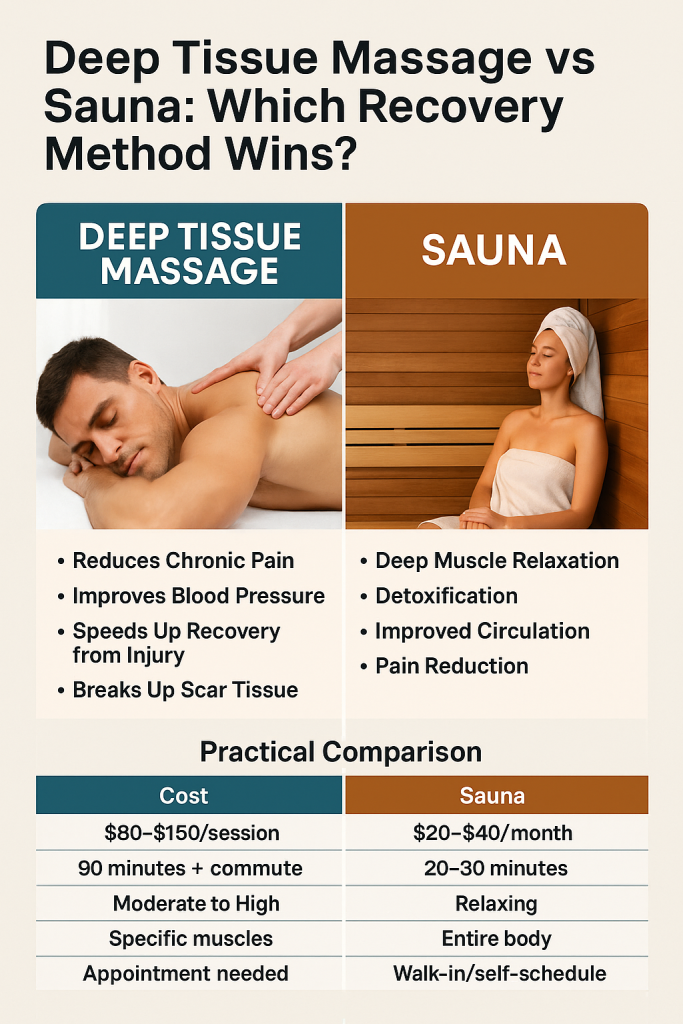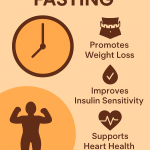Feeling tense, sore, or simply worn out? Most people instinctively book a deep tissue massage to ease those aches. But what if there’s a better, more practical option for long-term wellness? Enter the sauna. In today’s post, we’ll dive deep into the benefits of deep tissue massage, explore the growing science around sauna therapy, and ultimately help you decide which one fits your lifestyle better.
Whether you’re a weekend warrior, a busy professional, or someone looking to invest wisely in your health, understanding the differences between massage and sauna use could change how you recover forever.
What is Deep Tissue Massage?
Deep tissue massage is a therapeutic technique designed to target the deeper layers of muscles and connective tissues. Using slow strokes and firm pressure, massage therapists aim to release chronic tension patterns within the body.
How Deep Tissue Massage Works
- Focus on Trigger Points: Therapists work on knots and adhesions to restore proper movement and circulation.
- Techniques Used: Stripping (deep gliding pressure) and friction (pressure across the grain of muscles) are common.
- Typical Sessions: Last about 60–90 minutes and often focus on specific areas such as the back, neck, or shoulders.
Benefits of Deep Tissue Massage
- Reduces Chronic Pain
A study published in the Journal of Pain found that deep tissue massage can significantly reduce lower back pain and improve mobility. - Improves Blood Pressure
Research in Evidence-Based Complementary and Alternative Medicine showed participants experienced lowered systolic and diastolic blood pressure after massage therapy. - Speeds Up Recovery from Injury
Massage improves circulation, bringing more oxygen and nutrients to muscles. This accelerates healing and reduces inflammation. - Breaks Up Scar Tissue
Post-surgical patients or athletes recovering from injuries often benefit from deep tissue techniques that break down scar tissue, enhancing flexibility.
The Limitations of Deep Tissue Massage
Despite its many benefits, deep tissue massage isn’t without drawbacks:
- High Cost: Regular sessions can be expensive, ranging from $80–$150 per hour.
- Time Commitment: Booking appointments, commuting, and recovery time can be inconvenient.
- Pain and Discomfort: Some people experience soreness for days afterward.
- Limited Availability: Skilled therapists may have long waitlists, making consistent scheduling difficult.
Enter the Sauna: Nature’s Ancient Recovery Tool
What is a Sauna?
A sauna is a small room heated to temperatures between 150°F and 195°F, designed to induce sweating and promote relaxation. There are several types:
- Traditional Saunas: Heated with wood or electric stoves.
- Infrared Saunas: Use infrared heaters to emit light waves that heat the body directly.
- Steam Rooms: Offer high humidity with lower heat.
Benefits of Sauna Use for Recovery and Wellness
- Deep Muscle Relaxation
A study in the Journal of Human Kinetics showed that sauna use leads to muscle relaxation, reducing tension and stiffness across large muscle groups — without the discomfort of deep manual pressure. - Detoxification Through Sweating
Sweating helps flush out toxins like heavy metals and environmental chemicals from the body. Infrared saunas, in particular, are highly effective at promoting deep sweating. - Improved Circulation
The heat dilates blood vessels, improving blood flow. Research in Complementary Therapies in Medicine found that regular sauna users experience enhanced vascular function and lower risk of hypertension. - Pain Reduction
Heat therapy stimulates the release of endorphins, natural painkillers. In one Annals of Medicine study, sauna users reported a 30% reduction in chronic pain symptoms. - Boosted Immune System
Frequent sauna use is linked to a reduced incidence of colds and flu, thanks to heat stress training the body for more efficient immune responses.
Additional Sauna Benefits You Might Not Know
- Better Sleep: The drop in core body temperature after sauna use signals the brain to prepare for deep sleep, improving rest quality.
- Enhanced Skin Health: Sweating clears pores, removes dead skin cells, and promotes a healthy glow.
- Weight Management Support: While not a calorie-burning miracle, the relaxation and hormonal balance from sauna use can indirectly support better eating and exercise habits.
Sauna vs Deep Tissue Massage: A Practical Comparison
| Feature | Deep Tissue Massage | Sauna |
|---|---|---|
| Cost | $80–$150/session | $20–$40/month (membership) |
| Time Required | 90 minutes + commute | 20–30 minutes |
| Pain Factor | Moderate to high during/after | Relaxing, low pain |
| Muscle Recovery | Excellent for specific injuries | Excellent for whole body |
| Convenience | Requires appointment | Walk-in/self-schedule |
| Long-Term Wellness | Good, but episodic | Excellent, habitual |
Why a Sauna Might Be More Practical for Most People
Affordability: Sauna memberships, especially at gyms or wellness centers, are much cheaper than monthly massage therapy.
Consistency: You can sauna multiple times a week easily — no need for appointment juggling.
Whole-Body Recovery: While massage is incredible for specific problem areas, sauna therapy promotes recovery across the entire musculoskeletal system.
Low Risk of Discomfort: Sauna sessions are typically pleasurable, unlike deep tissue massage which can involve pain during or after.
Mental Health Boost: The tranquil, heated environment of a sauna is a natural space for mindfulness, helping reduce anxiety and boost overall emotional resilience.
Science Speaks: Studies on Sauna Benefits
Longevity and Heart Health
In a 20-year study involving 2,300 men (JAMA Internal Medicine), frequent sauna users (4–7 times per week) had:
- 63% lower risk of sudden cardiac death
- 50% lower risk of dying from cardiovascular disease
- 40% lower risk of all-cause mortality
These numbers are astounding — few interventions outside exercise and nutrition have shown comparable health benefits.
Mental Wellness
Research published in Psychosomatic Medicine found that regular sauna sessions reduced depression scores by up to 50%. This effect is linked to the release of neurotransmitters like serotonin and dopamine, both critical for mood regulation.
Combining Sauna and Massage: Best of Both Worlds?
While the sauna might offer broader, more practical benefits, there’s no need to ditch massages entirely! Some of the most effective wellness routines combine the two for maximum impact.
Suggested Routine:
- 2–3 Sauna Sessions Weekly: Promote recovery, cardiovascular health, and mental wellness.
- 1 Massage Monthly: Target lingering muscle knots, old injuries, and deep scar tissue work.
Pro Tip: Try doing a light sauna session before your massage to warm up tissues, making the massage even more effective and comfortable.
How to Get Started With Sauna Therapy
- Find a Local Facility
Look for gyms, spas, or health centers offering sauna access. Many memberships cost as little as $30 per month, with unlimited access. - Start Slowly
Begin with 10–15 minutes and gradually work up to 20–30 minutes. Always listen to your body. - Stay Hydrated
Drink plenty of water before and after your session. Bring a water bottle inside if needed. - Experiment with Timing
Some people prefer sauna use post-workout, while others enjoy it at night to wind down. See what fits best with your lifestyle. - Practice Mindfulness
Use your sauna time to meditate, breathe deeply, or simply unplug from technology.
Common Myths About Sauna Use
- Myth 1: Saunas Dehydrate You Dangerously
Truth: Proper hydration easily offsets any water loss from sweating. - Myth 2: Only Athletes Need Saunas
Truth: Office workers, parents, seniors — nearly everyone benefits from regular sauna therapy. - Myth 3: Saunas Burn Tons of Calories
Truth: While heart rate and metabolic rate rise during a session, saunas should be viewed as recovery tools, not fat-loss shortcuts. - Myth 4: Saunas Are Unsafe for Older Adults
Truth: Studies show elderly individuals can safely use saunas with proper precautions, and they may experience even greater cardiovascular benefits.
Final Thoughts: Sauna or Deep Tissue Massage?
While deep tissue massage offers fantastic, targeted relief, saunas present a more practical, cost-effective, and sustainable solution for full-body recovery and overall health.
Bottom Line:
If you want affordable, consistent wellness benefits — better sleep, reduced pain, stronger immunity, and lower stress — a sauna might just be your smartest move.
But don’t worry — there’s always room for a massage now and then, too. 🧖♀️🔥



